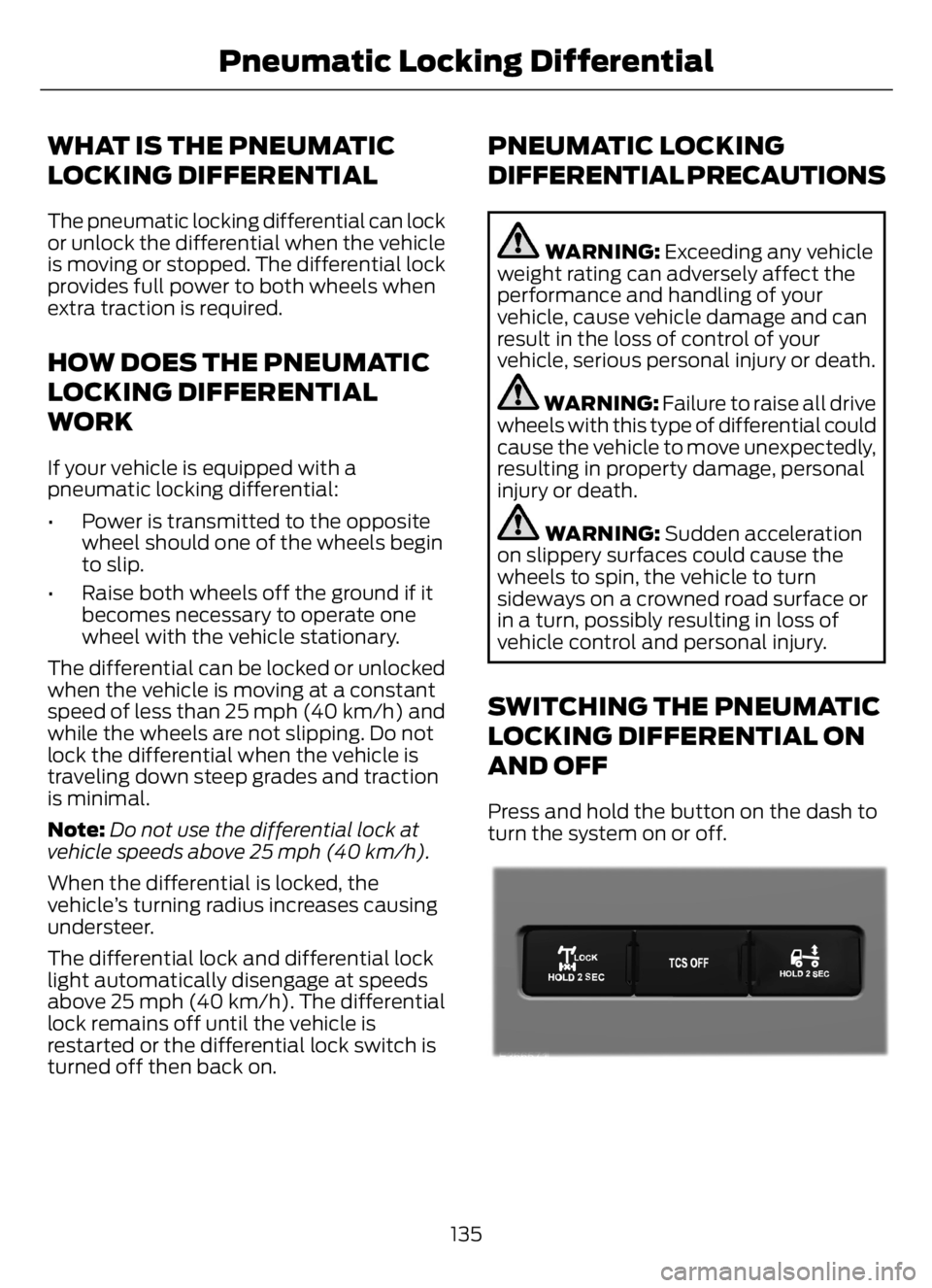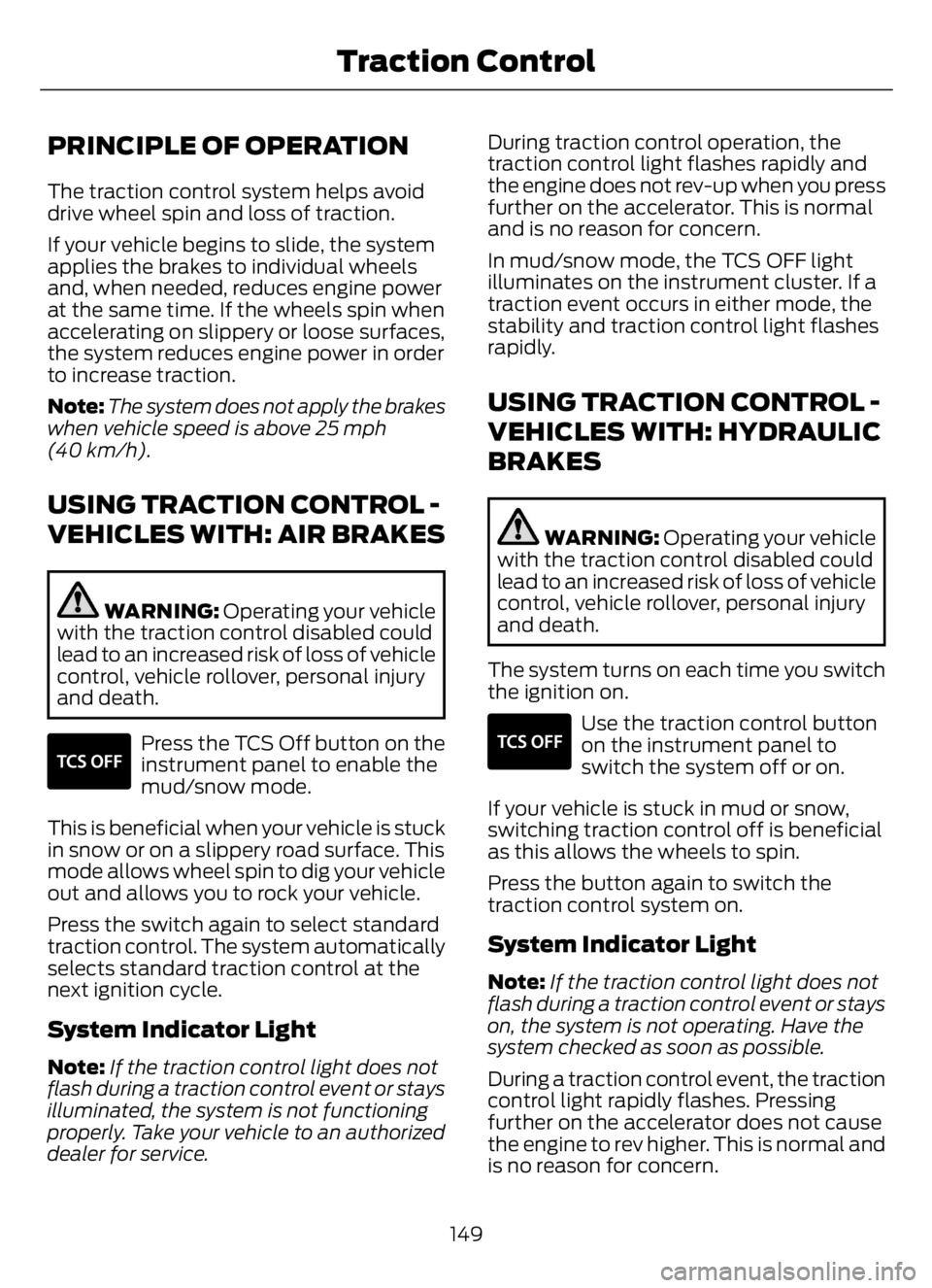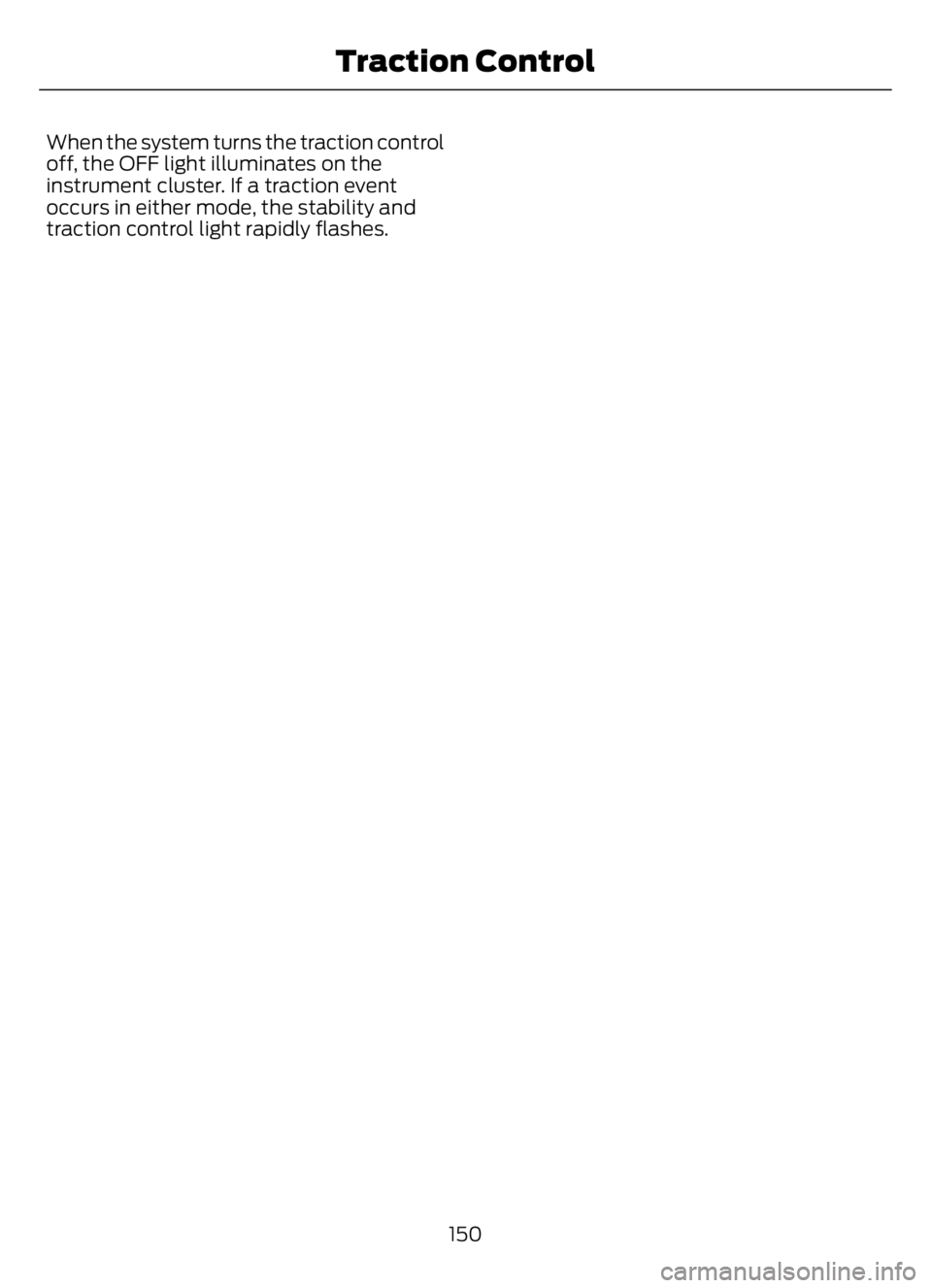2023 FORD F650/750 traction control
[x] Cancel search: traction controlPage 7 of 378

Pneumatic Locking Differ-
ential
What Is the Pneumatic Locking
Differential .................................................135
How Does the Pneumatic Locking
Differential Work ......................................135
Pneumatic Locking Differential
Precautions ................................................135
Switching the Pneumatic Locking
Differential On and Off ..........................135
Pneumatic Locking Differential
Indicators ....................................................136
Brakes
General Information ....................................137
Hints on Driving With Anti-Lock Brakes
.........................................................................138
Parking Brake ................................................138
Hill Start Assist ..............................................141
Air Brakes ........................................................142
Exhaust Brake ...............................................143
Trailer Brakes .................................................145
Traction Control
Principle of Operation ...............................149
Using Traction Control - Vehicles With:
Air Brakes ...................................................149
Using Traction Control - Vehicles With:
Hydraulic Brakes ......................................149
Stability Control
Principle of Operation - Vehicles With:
Hydraulic Brakes .......................................151
Principle of Operation - Vehicles With:
Air Brakes ....................................................152
Using Stability Control ...............................153
Cruise Control - Vehicles With:
Adaptive Cruise Control
Using Adaptive Cruise Control ................155
Cruise Control - Vehicles With:
Cruise Control
What Is Cruise Control ................................161
Switching Cruise Control On and Off
..........................................................................161
Setting the Cruise Control Speed ..........161
Canceling the Set Speed ..........................162
Resuming the Set Speed ..........................162
Cruise Control Indicators ..........................162
Driving Aids
Driver Alert .....................................................163
Lane Keeping System ................................164
Steering ...........................................................167
Pre-Collision Assist - Vehicles With: Air
Brakes ..........................................................168
Pre-Collision Assist - Vehicles With:
Hydraulic Brakes ......................................170
Load Carrying
Load Limit .......................................................175
Air Suspension ..............................................176
Towing
Towing a Trailer .............................................178
Recommended Towing Weights ............179
Essential Towing Checks .........................180
Fifth Wheel Operation ................................181
Driving Hints
General Driving Points ...............................183
Economical Driving .....................................184
Cold Weather Precautions .......................184
Breaking-In ....................................................186
Driving Through Water ...............................187
Roadside Emergencies
Roadside Assistance .................................188
Hazard Flashers ...........................................189
Fuel Shutoff ..................................................189
3
Table of Contents
Page 72 of 378

Powertrain Malfunction/Reduced
Power/Electronic Throttle Control
(If Equipped)
Illuminates in the event of a
powertrain fault. Have your
vehicle checked as soon as
possible.
Service Engine Soon
If it illuminates when the engine
is running, the on-board
diagnostics system notifies you
that the emission control system requires
service.
If it flashes, engine misfire may be
occurring. An increase in exhaust gas
temperatures can damage the catalytic
converter or other vehicle components.
Avoid heavy acceleration and deceleration
and have your vehicle immediately
serviced.
It illuminates when you switch the ignition
on prior to engine start to check the bulb
and to indicate whether your vehicle is
ready for Inspection and Maintenance
(I/M) testing.
Normally, it illuminates until the engine is
cranked and turns off if no malfunctions
are present. However, if after 15 seconds
it flashes eight times, this indicates that
your vehicle is not ready for inspection and
maintenance (I/M) testing.
See Catalytic Converter (page 116).
Stability Control Indicator (If Equipped)
E138639
Flashes during operation.
If it does not illuminate when you switch
the ignition on, or remains on when the
engine is running, this indicates a
malfunction. Have your vehicle checked
as soon as possible.
Traction Control Indicator
E138639
Flashes during a traction control
event.
If it does not illuminate when you switch
the ignition on, or remains on when the
engine is running, this indicates a
malfunction. Have your vehicle checked
as soon as possible.
Traction Control System Off
E194301
Illuminates when you switch the
system off.
Trailer Anti-Lock Brake System
(ABS)
E209040
Briefly illuminates when you
switch on the ignition, and only
when you connect a PLC trailer
or a PLC diagnostic tool. If the light fails to
illuminate, remains on after you start the
vehicle or continues to flash, have the
system immediately serviced.
Transmission Tow/Haul
E246592
Illuminates when you switch on
tow/haul. If the light steadily
flashes, have the system
immediately serviced, damage to the
transmission could occur.
Two Speed Axle (If Equipped)
E208809
The two speed axle indicator
comes on when you switch the
low axle range on.
Wait to Start (If Equipped)
Illuminates when you switch the
ignition on as part of the
pre-start system. Wait until the
wait to start indicator turns off before
attempting to start vehicle.
68
Instrument Cluster
Page 86 of 378

Power Steering
Action Message
The power steering system requires service.
Have the system checked as soon as
possible. Steering Fault Service Now
The power steering system is not working.
Stop your vehicle in a safe place. Have the
system checked as soon as possible. Steering Loss Stop Safely
The power steering system, passive entry
or passive entry start system requires
service. Have the system checked as soon
as possible. Steering Assist Fault Service Required
The steering lock system requires service.
Have the system checked as soon as
possible. Steering Lock Malfunction Service Now
Pre-Collision Assist
Action Message
The system requires service. Have the
system checked as soon as possible. Pre-Collision Assist Not Available
You have a blocked sensor due to
inclement weather, ice, mud or water in
front of the radar sensor. You can typically
clean the sensor to resolve. If the message
continues to appear, have the system
checked as soon as possible. Pre-Collision Assist Not Available Sensor
Blocked
Traction Control
Action Message
The status of the traction control system
after you switched it on. See Using Trac-
tion Control (page 149). Traction Control On
The status of the traction control system
after you switched it off. See Using Trac-
tion Control (page 149). Traction Control Off
82
Information Displays
Page 139 of 378

WHAT IS THE PNEUMATIC
LOCKING DIFFERENTIAL
The pneumatic locking differential can lock
or unlock the differential when the vehicle
is moving or stopped. The differential lock
provides full power to both wheels when
extra traction is required.
HOW DOES THE PNEUMATIC
LOCKING DIFFERENTIAL
WORK
If your vehicle is equipped with a
pneumatic locking differential:
• Power is transmitted to the opposite
wheel should one of the wheels begin
to slip.
• Raise both wheels off the ground if it
becomes necessary to operate one
wheel with the vehicle stationary.
The differential can be locked or unlocked
when the vehicle is moving at a constant
speed of less than 25 mph (40 km/h) and
while the wheels are not slipping. Do not
lock the differential when the vehicle is
traveling down steep grades and traction
is minimal.
Note:Do not use the differential lock at
vehicle speeds above 25 mph (40 km/h).
When the differential is locked, the
vehicle’s turning radius increases causing
understeer.
The differential lock and differential lock
light automatically disengage at speeds
above 25 mph (40 km/h). The differential
lock remains off until the vehicle is
restarted or the differential lock switch is
turned off then back on.
PNEUMATIC LOCKING
DIFFERENTIAL PRECAUTIONS
WARNING: Exceeding any vehicle
weight rating can adversely affect the
performance and handling of your
vehicle, cause vehicle damage and can
result in the loss of control of your
vehicle, serious personal injury or death.
WARNING: Failure to raise all drive
wheels with this type of differential could
cause the vehicle to move unexpectedly,
resulting in property damage, personal
injury or death.
WARNING: Sudden acceleration
on slippery surfaces could cause the
wheels to spin, the vehicle to turn
sideways on a crowned road surface or
in a turn, possibly resulting in loss of
vehicle control and personal injury.
SWITCHING THE PNEUMATIC
LOCKING DIFFERENTIAL ON
AND OFF
Press and hold the button on the dash to
turn the system on or off.
E366571E366571E366E366E366E366E366E36666E366E366E366EE36611571571571571557171571571571
135
Pneumatic Locking Differential
Page 153 of 378

PRINCIPLE OF OPERATION
The traction control system helps avoid
drive wheel spin and loss of traction.
If your vehicle begins to slide, the system
applies the brakes to individual wheels
and, when needed, reduces engine power
at the same time. If the wheels spin when
accelerating on slippery or loose surfaces,
the system reduces engine power in order
to increase traction.
Note:The system does not apply the brakes
when vehicle speed is above 25 mph
(40 km/h).
USING TRACTION CONTROL -
VEHICLES WITH: AIR BRAKES
WARNING: Operating your vehicle
with the traction control disabled could
lead to an increased risk of loss of vehicle
control, vehicle rollover, personal injury
and death.
E330660E330660
Press the TCS Off button on the
instrument panel to enable the
mud/snow mode.
This is beneficial when your vehicle is stuck
in snow or on a slippery road surface. This
mode allows wheel spin to dig your vehicle
out and allows you to rock your vehicle.
Press the switch again to select standard
traction control. The system automatically
selects standard traction control at the
next ignition cycle.
System Indicator Light
Note:If the traction control light does not
flash during a traction control event or stays
illuminated, the system is not functioning
properly. Take your vehicle to an authorized
dealer for service.During traction control operation, the
traction control light flashes rapidly and
the engine does not rev-up when you press
further on the accelerator. This is normal
and is no reason for concern.
In mud/snow mode, the TCS OFF light
illuminates on the instrument cluster. If a
traction event occurs in either mode, the
stability and traction control light flashes
rapidly.
USING TRACTION CONTROL -
VEHICLES WITH: HYDRAULIC
BRAKES
WARNING: Operating your vehicle
with the traction control disabled could
lead to an increased risk of loss of vehicle
control, vehicle rollover, personal injury
and death.
The system turns on each time you switch
the ignition on.
E330660E330660
Use the traction control button
on the instrument panel to
switch the system off or on.
If your vehicle is stuck in mud or snow,
switching traction control off is beneficial
as this allows the wheels to spin.
Press the button again to switch the
traction control system on.
System Indicator Light
Note:If the traction control light does not
flash during a traction control event or stays
on, the system is not operating. Have the
system checked as soon as possible.
During a traction control event, the traction
control light rapidly flashes. Pressing
further on the accelerator does not cause
the engine to rev higher. This is normal and
is no reason for concern.
149
Traction Control
Page 154 of 378

When the system turns the traction control
off, the OFF light illuminates on the
instrument cluster. If a traction event
occurs in either mode, the stability and
traction control light rapidly flashes.
150
Traction Control
Page 155 of 378

PRINCIPLE OF OPERATION -
VEHICLES WITH: HYDRAULIC
BRAKES
WARNING: Vehicle modifications
involving braking system, aftermarket
roof racks, suspension, steering system,
tire construction and wheel and tire size
may change the handling characteristics
of your vehicle and may adversely affect
the performance of the electronic
stability control system. In addition,
installing any stereo loudspeakers may
interfere with and adversely affect the
electronic stability control system. Install
any aftermarket stereo loudspeaker as
far as possible from the front center
console, the tunnel, and the front seats
in order to minimize the risk of interfering
with the electronic stability control
sensors. Reducing the effectiveness of
the electronic stability control system
could lead to an increased risk of loss of
vehicle control, vehicle rollover, personal
injury and death.
WARNING: Remember that even
advanced technology cannot defy the
laws of physics. It's always possible to
lose control of a vehicle due to
inappropriate driver input for the
conditions. Aggressive driving on any
road condition can cause you to lose
control of your vehicle increasing the risk
of personal injury or property damage.
Activation of the electronic stability
control system is an indication that at
least some of the tires have exceeded
their ability to grip the road; this could
reduce the operator's ability to control
the vehicle potentially resulting in a loss
of vehicle control, vehicle rollover,
personal injury and death. If your
electronic stability control system
activates, SLOW DOWN.
The system turns on each time you switch
the ignition on.
If a fault occurs in either the stability
control or the traction control system, the
following conditions are possible:
• The stability and traction control light
illuminate.
• The stability control and traction
control systems are not maintaining
traction of the wheels.
If a driving condition activates either the
stability control or the traction control
system, the following conditions are
possible:
• The stability and traction control light
flash.
• Your vehicle slows down.
• The system reduces engine power.
• A vibration in the brake pedal.
• The brake pedal is stiffer than usual.
• If the driving condition is severe and
your foot is not on the brake, the brake
pedal could move as the system
applies higher brake force.
The stability control system has several
features built into it to help you maintain
control of your vehicle:
Electronic Stability Control
The system assists in preventing skids or
lateral slides by applying the brakes to one
or more of the wheels individually and, if
necessary, decreases engine power.
151
Stability Control
Page 156 of 378

Traction Control
The system helps maintain traction of the
wheels by detecting and controlling wheel
spin. See Using Traction Control (page
149).
E72903
Vehicle without stability control
skidding off its intended route. A
Vehicle with stability control
maintaining control on a slippery
surface. B
PRINCIPLE OF OPERATION -
VEHICLES WITH: AIR BRAKES
WARNING: Vehicle modifications
involving braking system, aftermarket
roof racks, suspension, steering system,
tire construction and wheel and tire size
may change the handling characteristics
of your vehicle and may adversely affect
the performance of the electronic
stability control system. In addition,
installing any stereo loudspeakers may
interfere with and adversely affect the
electronic stability control system. Install
any aftermarket stereo loudspeaker as
far as possible from the front center
console, the tunnel, and the front seats
in order to minimize the risk of interfering
with the electronic stability control
sensors. Reducing the effectiveness of
the electronic stability control system
could lead to an increased risk of loss of
vehicle control, vehicle rollover, personal
injury and death.
WARNING: Remember that even
advanced technology cannot defy the
laws of physics. It's always possible to
lose control of a vehicle due to
inappropriate driver input for the
conditions. Aggressive driving on any
road condition can cause you to lose
control of your vehicle increasing the risk
of personal injury or property damage.
Activation of the electronic stability
control system is an indication that at
least some of the tires have exceeded
their ability to grip the road; this could
reduce the operator's ability to control
the vehicle potentially resulting in a loss
of vehicle control, vehicle rollover,
personal injury and death. If your
electronic stability control system
activates, SLOW DOWN.
The system automatically turns on each
time you switch the ignition on.
If a fault occurs in either the stability
control or the traction control system, you
may experience the following conditions:
• The stability and traction control light
illuminates steadily.
152
Stability Control